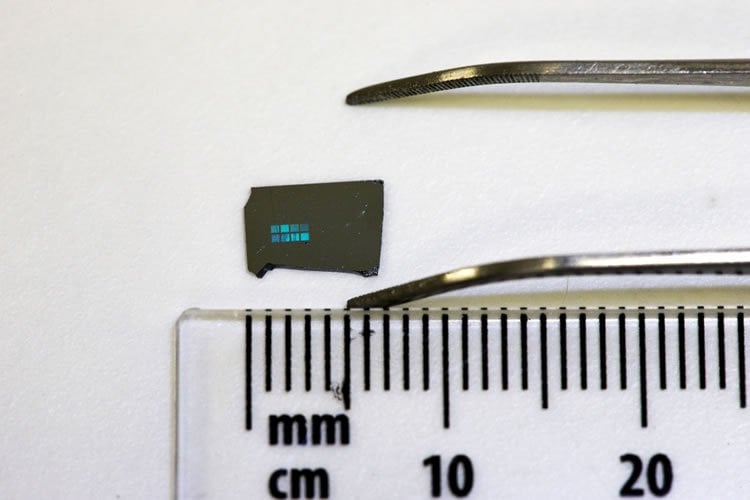Summary: New technology could help with the development for neuroprosthetic devices.
Source: ANU.
Researchers at The Australian National University (ANU) have developed a suitable material to allow brain cells to grow and form predictable circuits, which could lead to the development of prosthetics for the brain.
Researchers grew the brain cells on a semiconductor wafer patterned with nanowires which act as a scaffold to guide the growth of brain cells.
Lead researcher Dr Vini Gautam from the Research School of Engineering at ANU said the scaffold provides a platform to study the growth of the brain cells and how they connect with each other.
“The project will provide new insights into the development of neuro-prosthetics which can help the brain recover after damage due to an accident, stroke or degenerative neurological diseases,” Dr Gautam said.
The study is the first to show the neuronal circuits grown on the nanowire scaffolds were functional and highly interconnected, opening the potential to apply their scaffold design for neuro-prosthetics.
Project group leader Dr Vincent Daria from The John Curtin School of Medical Research hopes to use the brain on a chip to understand how neurons in the brain form computing circuits and eventually process information.
“Unlike other prosthetics like an artificial limb, neurons need to connect synaptically, which form the basis of information processing in the brain during sensory input, cognition, learning and memory,” Dr Daria said.
“Using a particular nanowire geometry, we have shown that the neurons are highly interconnected and predictably form functional circuits.”

Dr Daria said it was important to build up the appropriate environment where neurons can be predictably connected into functional circuits.
“We were able to make predictive connections between the neurons and demonstrated them to be functional with neurons firing synchronously,” he said.
“This work could open up new research model that builds up a stronger connection between materials nanotechnology with neuroscience.”
The research was a multi-disciplinary collaboration between physics, engineering and neuroscience.
The nanowires were fabricated by a group led by Professor Chennupati Jagadish at the Research School of Physics and Engineering at ANU.
Source: ANU
Image Source: NeuroscienceNews.com image is credited to the researchers.
Original Research: Abstract for “Engineering Highly Interconnected Neuronal Networks on Nanowire Scaffolds” by Vini Gautam, Shagufta Naureen, Naeem Shahid, Qian Gao, Yi Wang, David Nisbet, Chennupati Jagadish, and Vincent R. Daria in Nano Letters. Published online April 24 2017 doi:10.1021/acs.nanolett.6b05288
[cbtabs][cbtab title=”MLA”]ANU “Engineers Build Brain on a Chip.” NeuroscienceNews. NeuroscienceNews, 15 May 2017.
<https://neurosciencenews.com/brain-on-chip-neuroengineering-6671/>.[/cbtab][cbtab title=”APA”]ANU (2017, May 15). Engineers Build Brain on a Chip. NeuroscienceNew. Retrieved May 15, 2017 from https://neurosciencenews.com/brain-on-chip-neuroengineering-6671/[/cbtab][cbtab title=”Chicago”]ANU “Engineers Build Brain on a Chip.” https://neurosciencenews.com/brain-on-chip-neuroengineering-6671/ (accessed May 15, 2017).[/cbtab][/cbtabs]
Abstract
Engineering Highly Interconnected Neuronal Networks on Nanowire Scaffolds
Identifying the specific role of physical guidance cues in the growth of neurons is crucial for understanding the fundamental biology of brain development and for designing scaffolds for tissue engineering. Here, we investigate the structural significance of nanoscale topographies as physical cues for neurite outgrowth and circuit formation by growing neurons on semiconductor nanowires. We monitored neurite growth using optical and scanning electron microscopy and evaluated the spontaneous neuronal network activity using functional calcium imaging. We show, for the first time, that an isotropic arrangement of indium phosphide (InP) nanowires can serve as physical cues for guiding neurite growth and aid in forming a network with neighboring neurons. Most importantly, we confirm that multiple neurons, with neurites guided by the topography of the InP nanowire scaffolds, exhibit synchronized calcium activity, implying intercellular communications via synaptic connections. Our study imparts new fundamental insights on the role of nanotopographical cues in the formation of functional neuronal circuits in the brain and will therefore advance the development of neuroprosthetic scaffolds.
“Engineering Highly Interconnected Neuronal Networks on Nanowire Scaffolds” by Vini Gautam, Shagufta Naureen, Naeem Shahid, Qian Gao, Yi Wang, David Nisbet, Chennupati Jagadish, and Vincent R. Daria in Nano Letters. Published online April 24 2017 doi:10.1021/acs.nanolett.6b05288







